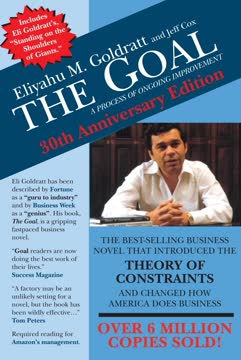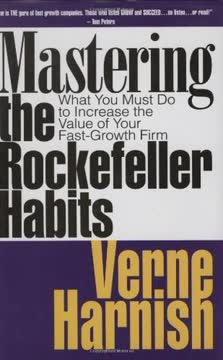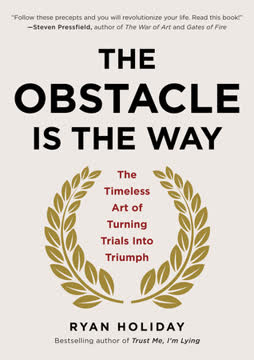Key Takeaways
1. The Middle Class is Shrinking; Target the Affluent
To prosper you need an ample supply of customers with two attributes: ABILITY to buy and WILLINGNESS to buy. Both as a constant.
Economic Shift. The middle class is shrinking due to automation, technology, and economic policies, making it a less reliable target market. Businesses must adapt by shifting their focus to the affluent, who possess both the ability and willingness to spend consistently, regardless of economic fluctuations. This shift is not just about chasing money; it's about building a sustainable business model that can withstand economic downturns.
Ability and Willingness. The affluent have a higher percentage of disposable income, meaning they spend a smaller portion of their income on necessities, leaving more for discretionary purchases. They also tend to be more optimistic and resilient, making them more reliable customers. This contrasts sharply with the middle class, whose spending is more volatile and tied to economic conditions.
Strategic Imperative. Targeting the affluent is not just a matter of preference; it's a strategic imperative for long-term business survival and growth. Businesses that fail to adapt to this economic shift risk becoming obsolete. This requires a fundamental change in mindset, marketing, and sales strategies.
2. Affluent Consumers: Diverse, Dynamic, and Defined by Net Worth
Throughout this book, I’m going to subdivide the affluent population many different ways.
Beyond Income. Affluence is not solely defined by income but also by net worth, which includes assets like investments, real estate, and savings. This distinction is crucial because net worth provides a more accurate picture of a consumer's long-term spending power and financial stability. The book subdivides the affluent into mass-affluent, affluent, and ultra-affluent categories, each with distinct characteristics.
Mass-Affluent. This group, often considered "upper middle class," has household incomes ranging from $85,000 to $150,000 and/or a net worth exceeding $350,000. They are diverse in age, ethnicity, and occupation, and they shop at a mix of mainstream and premium retailers. They are upwardly mobile and represent a significant market segment.
Affluent and Ultra-Affluent. Affluent individuals have household incomes from $150,000 to $250,000 and/or a net worth exceeding $1 million, while the ultra-affluent have incomes of $250,000+ and/or a net worth of $3 million to $10 million. These groups control a disproportionate share of wealth and spending power, making them highly desirable targets for businesses. They are also more likely to be investors and business owners.
3. The Ultra-Rich: A World Apart, Yet Driven by Familiar Needs
The very rich are different from you and me. Yes, they have more money.
Beyond the Myths. The ultra-rich are often portrayed as a monolithic group of inheritors, but the majority are self-made entrepreneurs who have achieved their wealth through ambition, hard work, and ingenuity. They are not necessarily college educated, and many have faced significant adversity in their lives. This is important to understand when marketing to them.
Common Traits. Despite their wealth, the ultra-rich share common needs and motivations with other affluent groups, including a desire for recognition, respect, and validation. They are also driven by a need for efficiency, convenience, and competence. They are methodical, process-oriented, and deeply suspicious of anything that doesn't reflect hard work and methodical development.
Marketing Implications. Marketing to the ultra-rich requires a deep understanding of their values and motivations. It's not enough to simply offer luxury goods; you must also provide a compelling story, a sense of exclusivity, and a high level of personalized service. They are not interested in handouts or freebies, but they are willing to pay a premium for quality and expertise.
4. Women: The Power Spenders, Often Overlooked
It is no secret that, as the old saying goes, “women control the purse strings.”
Shifting Dynamics. Women are increasingly making financial decisions, both jointly with their spouses and independently. Single women are a growing force in the housing market and other sectors. This shift requires marketers to move beyond traditional gender stereotypes and recognize women as powerful economic actors.
Beyond Stereotypes. Affluent women are not a monolithic group. They have diverse needs, interests, and motivations. Some are savvy investors, while others are financially uninvolved. Some are focused on career, while others are focused on family. Marketing to women requires a nuanced approach that acknowledges these differences.
Opportunities for Marketers. Affluent women are willing to spend on themselves, their families, and their homes. They are particularly interested in health, beauty, aging, and lifestyle issues. They are also a prime source of money for grandkids' activities and education. Marketers who understand these needs and can provide relevant solutions will be well-positioned to succeed.
5. Men: Driven by Status, Competition, and Toys
Man will do many things to get himself loved. He will do all things to get himself envied.
Emotional Drivers. Despite the myth of men being practical and logical, they are often driven by emotions, particularly the need for status, competition, and validation. They buy things to signal their success and to gain the envy of others. This is why luxury cars, yachts, and other "toys" are so appealing to affluent men.
Status and Competition. Men often seek status through competition and comparison with their peers. They are driven by a need for dominance, which manifests in their consumer behavior. This means that a purchase is never just about the product itself; it's also about how it positions them relative to others.
Marketing Implications. Marketing to affluent men requires an understanding of their desire for status and recognition. It's important to offer products and services that convey a sense of exclusivity, achievement, and superiority. Tiered pricing and visible privilege are powerful tools for appealing to this demographic.
6. LGBTQ+ Affluents: A Lucrative, Underserved Market
When it is a question of money, everyone is of the same religion.
Significant Spending Power. The LGBTQ+ community represents a significant and growing market with substantial spending power. They often have higher incomes and fewer financial obligations, making them a highly desirable target for businesses. They are also more likely to spend on travel, technology, and luxury goods.
Underserved Market. Despite their economic importance, the LGBTQ+ community is often overlooked or misunderstood by marketers. Many businesses are hesitant to target this group due to discomfort or lack of understanding. This creates a significant opportunity for businesses that are willing to embrace inclusivity and create targeted marketing campaigns.
Targeted Marketing. Reaching the LGBTQ+ community requires a nuanced approach that acknowledges their diversity and avoids stereotypes. It's important to use LGBTQ+-specific media, support LGBTQ+ organizations, and create welcoming and inclusive environments. Targeted marketing can be highly effective, but it must be done with sensitivity and authenticity.
7. Boomers: A Spending Boom Fueled by New Attitudes
He’s living beyond his means, but he can afford it.
Wealthiest Generation. Boomers are the wealthiest generation in history, with a median net worth of $913,000. They are also actively spending their money on themselves, their homes, and their lifestyles. They are not retiring in the traditional sense but are instead extending their work lives and pursuing new ventures.
New Attitudes. Boomers have a different attitude toward aging and retirement than previous generations. They are more active, more mobile, and more interested in experiences than material possessions. They are also more likely to have multiple residences and to travel frequently.
Marketing Opportunities. Marketing to Boomers requires an understanding of their desire for ease, convenience, and time-saving solutions. They are also looking for products and services that are specifically designed for them, but without being condescending or making them feel old. They are a prime source of money for grandkids' activities, travel, and education.
8. Self-Made Affluents: Respect Hustle, Value Hard Work
I don’t think of myself as a poor deprived ghetto girl who made good. I think of myself as somebody who from an early age knew I was responsible for myself, and I had to make good.
Entrepreneurial Spirit. A significant portion of the affluent population is self-made, having achieved their wealth through entrepreneurship, hard work, and ingenuity. They deeply value these qualities and are drawn to others who share their work ethic and drive. They are methodical, process-oriented, and deeply suspicious of anything that doesn't reflect hard work and methodical development.
Values-Based Marketing. Marketing to self-made affluents requires an understanding of their values. They are not impressed by handouts or freebies, but they are drawn to those who demonstrate ambition, initiative, and a willingness to work hard. They also value transparency, honesty, and integrity.
Business Owners as Ideal Clients. Self-employed affluent individuals, particularly business owners and entrepreneurs, are often the best customers. They are more likely to be open to new ideas, willing to invest in their own growth, and have a strong sense of personal responsibility. They also tend to be more competitive and status-conscious.
9. Optimism: A Key Driver of Affluent Spending
In all likelihood, world inflation is over.
Positive Outlook. Optimism is a key driver of affluent spending. They tend to be more confident in their financial future and more willing to invest in new opportunities. They are also more likely to respond to positive messages and to be drawn to marketers who share their optimistic outlook.
Resilience and Reliability. Affluent consumers are more resilient to economic downturns and less likely to be swayed by negative news. They have a strong sense of personal control and are more likely to view economic challenges as temporary setbacks rather than permanent obstacles. This makes them a more reliable customer base.
Marketing Implications. Marketing to the affluent requires a positive and forward-looking approach. It's important to focus on opportunities, solutions, and the potential for growth. Avoid fear-based marketing and instead emphasize the benefits of your products and services.
10. Affluent Tribalism: Seek Belonging, Validate Superiority
I do not wish to be in any club that would have me as a member.
Desire for Separation. Affluent individuals often seek to separate themselves from the masses, creating their own exclusive tribes and communities. This desire for segregation is driven by a need for validation, recognition, and a sense of belonging among their peers. They seek to be with like-minded people.
Symbolic Gates. Gated communities, private clubs, and other exclusive environments are not just about security; they are also about signaling status and belonging. These symbols of exclusion serve to reinforce the affluent's sense of superiority and their desire to be different from the rest.
Marketing Implications. Marketing to the affluent requires an understanding of their desire for exclusivity and belonging. It's important to create a sense of community around your brand and to offer products and services that are not readily available to everyone. This can be achieved through tiered pricing, exclusive events, and personalized service.
11. The Affluent E-Factors: Insecurity, Validation, and More
There is perhaps no feeling more acute than being left out.
Emotional Drivers. Affluent consumers are driven by a unique set of emotional factors, including insecurity, fear of being found out, a desire to avoid faux pas, and a need for validation. They are also motivated by a desire to fill emotional emptiness and to give themselves "gold stars" for their accomplishments.
Insecurity and Validation. Despite their wealth, affluent individuals often struggle with insecurity and a fear of losing their status. They seek validation from others and are highly sensitive to judgment. They are also driven by a desire to be seen as successful and accomplished.
Marketing Implications. Marketing to the affluent requires an understanding of their emotional needs. It's important to offer products and services that provide a sense of security, validation, and belonging. It's also important to avoid language or approaches that might be perceived as condescending or judgmental.
12. Stop Selling Products; Sell Experiences and Transformation
To be an Imagineer, it’s important to keep reality at arm’s length.
Beyond Functionality. Affluent consumers are not primarily interested in the functional aspects of products and services. They are more interested in the experiences and transformations that those products and services can provide. They are looking for solutions that enhance their lives, not just solve a problem.
The Experience Economy. The affluent are increasingly drawn to experiences that are unique, memorable, and transformative. They are willing to pay a premium for personalized service, exclusive access, and opportunities to indulge their passions. This shift requires businesses to move beyond product-centric marketing and focus on creating compelling experiences.
Marketing Implications. Marketing to the affluent requires a focus on the emotional benefits of your products and services. It's important to create a sense of aspiration, excitement, and transformation. You must also be able to deliver on the promises you make, providing a high level of service and attention to detail.
Last updated:
FAQ
What's No B.S. Marketing To the Affluent about?
- Targeting Affluent Consumers: The book emphasizes the importance of focusing marketing efforts on affluent consumers, who have more disposable income and a greater willingness to spend.
- Consumer Behavior Insights: It explores the psychology of affluent consumers, including their motivations and spending habits, which are crucial for effective marketing.
- Practical Strategies: Offers actionable strategies for marketing to affluent consumers, such as creating compelling offers and experiences that align with their desires and values.
Why should I read No B.S. Marketing To the Affluent?
- Expert Insights: Written by Dan S. Kennedy, a renowned marketing expert, the book provides valuable insights based on extensive experience.
- Target Audience Focus: Essential for business owners and marketers looking to pivot their efforts towards affluent consumers for increased sales and profitability.
- Actionable Advice: Filled with practical advice and real-world examples that can be immediately applied to improve business outcomes.
What are the key takeaways of No B.S. Marketing To the Affluent?
- Shift to Affluence: Businesses should target affluent consumers for a more stable and lucrative market, essential for long-term sustainability.
- Emotional Drivers: Understanding emotional factors influencing affluent consumers' purchasing decisions is crucial for crafting effective marketing messages.
- Unique Experiences: Emphasizes offering unique and memorable experiences to enhance customer loyalty and increase sales.
What are the best quotes from No B.S. Marketing To the Affluent and what do they mean?
- “You must now, aggressively, adapt. Or die.”: Highlights the urgency for businesses to adapt their strategies to target affluent consumers to avoid decline.
- “Recognition Does Matter”: Stresses the importance of status and recognition among affluent consumers, suggesting marketers create offers that enhance consumer status.
- “You are not your customer”: Reminds marketers not to project their own values onto their audience, emphasizing the need to understand affluent consumers' unique motivations.
How does No B.S. Marketing To the Affluent define affluent consumers?
- Affluent Classifications: Categorizes affluent consumers into groups like mass-affluent, affluent, and ultra-affluent, each with distinct income markers.
- Spending Power: Characterized by significant disposable income and a focus on quality and experience over price sensitivity.
- Psychological Traits: Discusses traits like the desire for recognition and status, essential for effective marketing.
What marketing strategies does No B.S. Marketing To the Affluent recommend?
- Targeted Messaging: Advises creating messages that resonate with affluent consumers' values, emphasizing exclusivity and quality.
- Utilizing E-Factors: Introduces E-Factors, emotional drivers that influence purchasing decisions, which marketers should leverage.
- Experience Over Product: Stresses selling experiences rather than just products to enhance customer satisfaction and loyalty.
How does No B.S. Marketing To the Affluent address consumer willingness to buy?
- Willingness vs. Ability: Highlights the importance of identifying consumers with both the ability and willingness to buy, especially among the affluent.
- Optimism and Spending: Discusses how consumer optimism influences spending, particularly on luxury goods and services.
- Psychological Triggers: Outlines triggers like social proof and exclusivity that enhance willingness to buy, which marketers should incorporate.
What are the emotional drivers (E-Factors) discussed in No B.S. Marketing To the Affluent?
- Insecurity: Affluent consumers may feel insecure about their status, driving them to purchase products that enhance it.
- Fear of Being Found Fakers: Concerns about authenticity can be addressed by focusing on genuine value in marketing strategies.
- Desire for Recognition: The need for recognition is a strong driver, and marketers should create opportunities for consumers to feel valued.
How does No B.S. Marketing To the Affluent suggest businesses can create unique experiences?
- Personalization: Emphasizes tailoring experiences to meet affluent consumers' specific desires, enhancing satisfaction.
- Memorable Interactions: Suggests creating exceptional customer service or unique offerings to differentiate in a competitive market.
- Emotional Engagement: Engaging consumers emotionally through storytelling can create deeper connections and increase spending.
What role does status play in the purchasing decisions of affluent consumers according to No B.S. Marketing To the Affluent?
- Status Symbolism: Many purchases serve as status symbols, appealing to affluent consumers seeking exclusivity and prestige.
- Peer Approval: Affluent individuals often seek peer approval, influencing their purchasing decisions and marketing strategies.
- Emotional Validation: The desire for status is tied to emotional validation, and marketing should tap into this to resonate with affluent buyers.
How can I apply the concepts from No B.S. Marketing To the Affluent to my business?
- Identify Your Target Market: Focus on the affluent segment that aligns with your business, understanding their needs and preferences.
- Develop Compelling Offers: Create offers that resonate with affluent consumers, using urgency and exclusivity to enhance appeal.
- Implement Direct Response Techniques: Use direct response marketing to track results and refine strategies based on data.
What is the significance of pricing strategies in No B.S. Marketing To the Affluent?
- Price Elasticity: Affluent consumers are less sensitive to price changes, allowing for higher pricing without losing customers.
- Perceived Value: Focus on creating a strong value proposition to justify premium pricing.
- Avoiding Price Comparison: Create unique offerings that stand out, making price comparisons less relevant.
Review Summary
No B.S. Marketing To the Affluent receives mixed reviews, with an overall rating of 4.12/5. Readers appreciate Kennedy's insights into affluent consumer psychology and marketing strategies. However, some criticize his writing style, political views, and perceived insensitivity. The book is praised for its practical advice and case studies but criticized for being repetitive and occasionally overwhelming. Some readers find Kennedy's approach too focused on wealthy white males, while others value his direct, no-nonsense approach to marketing to affluent customers.
Similar Books










Download PDF
Download EPUB
.epub digital book format is ideal for reading ebooks on phones, tablets, and e-readers.













